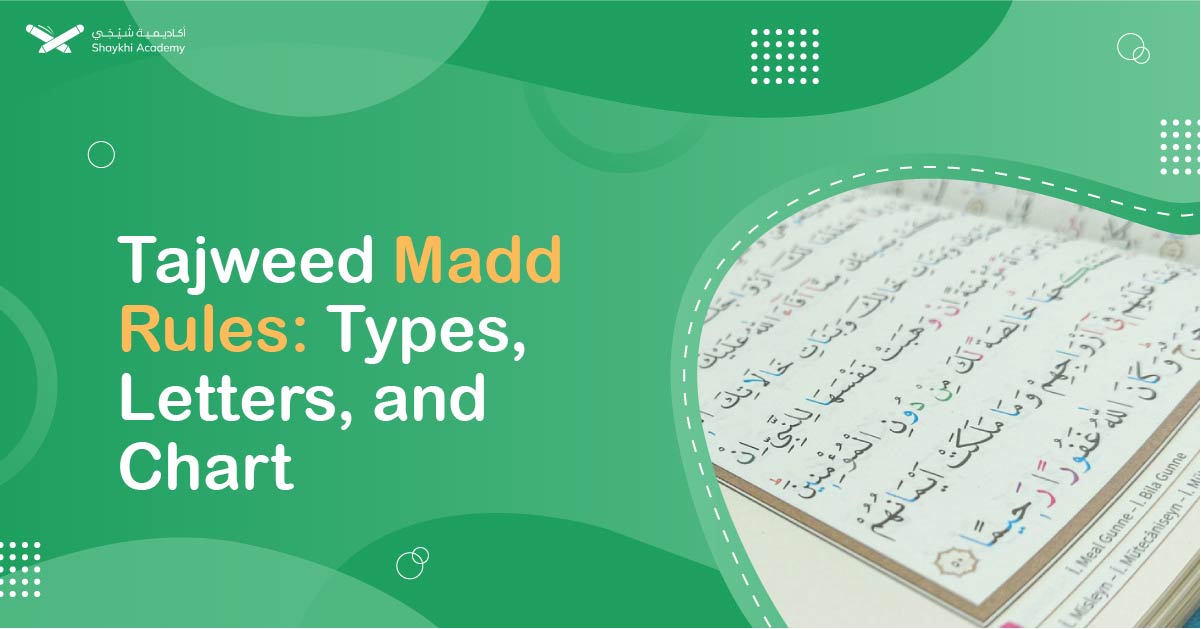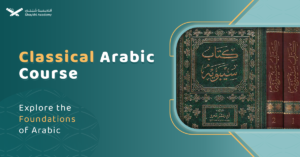Madd, or elongation, in Tajweed, refers to extending the sound of a vowel or certain soft consonants. There are two main types: Original Madd (Madd Asli) and Secondary Madd (Madd Far’i).
Original Madd occurs naturally and lasts for two beats (harakat). It includes Permanent Natural Madd, consistent in both continuous and paused recitation, and Madd al-‘Iwad, which appears only during pauses.
Secondary Madd depends on external factors like following Hamza or Sukoon for its extension. Examples include Madd al-Badl, where a Hamza precedes a Madd letter, and Madd al-Wajib al-Muttasil, where a Madd letter is followed by a Hamza in the same word.
Understanding these distinctions is crucial for proper Quranic recitation, ensuring correct elongation according to the rules of Tajweed.
Among the important Tajweed rules in the Quran is the ruling of Madd (prolongation). Madd refers to the elongation of specific vowel sounds in the Quranic recitation. Learning and applying these rules is crucial for proper pronunciation and beautification of the Quranic recitation, ensuring the correct delivery of the words and their meanings as intended in the holy text.
Read more about: Al-Madd Al-Aarid Lissukoon
What is Madd in tajweed?
Extension (Madd) is the prolongation of the sound of a vowel (Haruf al-Madd) or one of the soft letters (Haruf al-Leen).
What is madd in arabic tajweed?
“إطالة الصوت بحرف من حروف المد أو بأحد حرفي اللين”
the elongation of sound with one of the letters of Madd or one of the letters of Leen. It means extending the sound of one of the three Madd letters (Alif, Waw, and Ya) or one of the two Leen letters under certain conditions.
Haruf al-Madd (Letters of Madd):
The silent (Alif) preceded by a Fatha (ا)
The silent (Yaa) preceded by a Kasra (ي)
The silent (Waw) preceded by a Damma (و)
Haruf al-Leen (Soft Letters):
The silent (Waw) following a Fatha, as in “خوْف” (khawf)
The silent (Yaa) following a Fatha, as in “صيْف” (sayf)
Types of Madd:
Madd (elongation) in Tajweed is divided into two main categories: Original Madd (Natural Madd) and Secondary Madd.
Original Madd (Madd Asli) is the natural elongation that occurs without any external cause and lasts for two beats (harakat). It forms the basis for all other types and includes different subtypes like Permanent Natural Madd, which remains consistent in both continuous and paused recitation, and Madd al-‘Iwad, which appears only when pausing.
Secondary Madd depends on an external cause like a Hamza (ء) or Sukoon (a stillness or absence of vowel sound) for its extension. Examples include Madd al-Badl, where a Hamza precedes a Madd letter, and Madd al-Wajib al-Muttasil, where a Madd letter is followed by a Hamza in the same word. Secondary Madd is more complex and can vary in duration depending on specific conditions during recitation.
Let’s discuss all of these types of Madd in more details:
The first Type of Madd Is the Original Madd (Madd Asli):
Madd Asli is the Madd that the letter itself cannot exist without, and it has no external cause. It is also defined as the Madd where there is no Hamza or Sukoon after it, and its duration is two Harakat (two beats).
It is called natural Madd because a person with a natural pronunciation extends it for exactly two beats. It is also called original Madd because it is the basis for all other forms of Madd and because the Madd letter is only distinguishable from a short vowel through this extension.
Some scholars estimate the duration of the two beats as the time it takes to pronounce two consecutive letters, such as “قَ قَ”.
Original Madd (madd asli) can be divided into several types:
1. Permanent Natural Madd in Both Connection and Pause:
This type المد الطبيعي الثابت حال الوصل والوقف remains consistent whether the recitation is continuous or paused.
Examples from holy Quran:
In the verse: “قَالُواْ رَبَّنَا” (Al-Baqarah: 250) – (“Qālū Rabbanā”)
In the verse: “هَـٰذَا رَبِّى” (Al-An’am: 76) – (“Hādhā Rabbī”)
In the word “هذا” , the Alif (ا) is elongated by two counts (harakat), which is known as Natural Madd (Al-Madd Al-Asli).
2. Natural Madd Permanent in Pause but Not in Connection (Madd al-‘Iwad):
Madd al-‘Iwad appears only when pausing and not during continuous recitation.
Example from holy Quran:
In these verse, there is Madd al-‘Iwad (Compensation Madd) in the case of a stop (waqf).
“عَلِيمًا حَكِيمًا” (An-Nisa: 17) – (“‘Alīmā Ḥakīmā”)
When we pause at the word “حكيمًا” (Hakiman), we drop the tanween (nunation) and instead elongate the Alif (ا) at the end of the word by two counts (harakat). This is known as Madd Al-Iwad (Substitution Madd).
3. Natural Madd Permanent in Connection but Not in Pause:
This type المد الطبيعي الثابت حال الوصل والوقف appears only in continuous recitation and not when pausing.
Examples from holy Quran:
In the verse: “بِيَدِهِ مَلَكُوتُ” (Al-Mu’minun: 88) – (“Biyadihi Malakūtu”)
In the verse: “إِنَّهُ هُوَ” (Al-Baqarah: 37) – (“Innahu Huwa”)
When we connect the words during recitation, we elongate the Dammah on the letter “Ha” (ـه) in the word “إنه” (Innahu) by two counts (harakat). However, if we pause at the word “إنه” (Innahu), we do not apply the rule of elongation.
Natural Madd in the Spelling of the Openings of Some Surahs (Madd of Huruf Muqatta’at):
This appears in the initial letters of some chapters of the Quran.
Example from holy Quran:
In the verse: “كهيعص” (Surah Maryam: 1) – (“Kaf Ha Ya Ain Sad”)
We elongate each of the letters Kaaf (ك), Haa (هـ), Yaa (ي), Ain (ع), and Saad (ص) by two counts (harakat).
Read more about nabr in tajweed
The Second Type of Madd is the Secondary Madd المد الفرعي:
Al-Madd al-Far’i المد الفرعي or the Secondary Madd is the Madd that depends on an external cause for its extension, and the letters can exist without it.
Secondary Madd is divided into two categories:
1. Secondary Madd Due to Hamza:
This is the type of elongation (Madd) that occurs when a Hamza (ء) follows a Madd letter, whether in the same word or in the following word.
This has three types:
A. Madd al-Badl:
Madd al-Badl occurs when a Hamza precedes a Madd letter in a single word. The Hamza referred to here is specifically the Hamza of Qat’ (قطع). This Madd applies only if there is no Hamza or Sukoon following the Madd letter, as the presence of either would change it into another type of Madd. In some books of Tajweed, Madd al-Badl is defined as “every elongated Hamza.” This definition is metaphorical because the elongation occurs in the Madd letter that has either changed from a Hamza or comes after the Hamza.
In this case, both elongation and non-elongation are permissible
Examples from holy Quran:
in the verse:
“فَكَيْفَ آسَى عَلَى قَوْمٍ كَافِرِينَ” (Al-A’raf: 93) – (“Fakayfa Asa Ala Qawmin Kafirin”)
The original form of “آسَى” (Asa) is “أَأْسَى” (A’asa), where the silent Hamza is replaced by an Alif because the first Hamza is open. Similar examples include:
- “آدم” originally “أَأْدَم” (Adam originally “A’adam”)
- “آتى” originally “أَأْتَى” (Atā originally “A’ata”)
B. Mandatory Connected Madd (madd wajeb mutasel):
Madd al-Wajib al-Muttasil occurs when a Madd letter is followed by a Hamza in the same word. It is called “Wajib” (mandatory) because all reciters agree on prolonging it more than two counts. It is termed “Muttasil” (connected) because the Madd and the Hamza are found in a single word.
The length of this Madd is four or five counts (harakat)
Example from holy Quran:
in the verse:
“وَمَا تَفَرَّقَ الَّذِينَ أُوتُوا الْكِتَابَ إِلَّا مِن بَعْدِ مَا جَاءتْهُمُ الْبَيِّنَةُ” (Al-Bayyina: 4) – (“Wa Mā Tafarraqa Al-Ladhīna Ūtū Al-Kitāba Illā Min Ba`di Mā Jā’at/humu Al-Bayyina”).The alif (أ) in the word (Jā’at/humu) is elongated with six counts (harakat).
C. Permissible Separated Madd (madd jaez munfasel):
Madd al-Jaiz al-Munfasil occurs when a Madd letter appears at the end of a word, followed by a Hamza at the beginning of the next word. It is termed “Jaiz” (permissible) because it can either be shortened or elongated according to different recitations. It can be prolonged only for the natural Madd duration (two counts) or extended for more than that (four or six counts).
It is called “Munfasil” (separated) because the Madd letter is in one word and the Hamza is in a separate word.
This type of Madd occurs only during the connection (wasl) of the two words. When stopping at the first word, the reason for the Madd (the Hamza) disappears, reverting the Madd back to a natural Madd.
Example from the Holy Quran:
in the verse:
“وَإِذَا انقَلَبُواْ إِلَى أَهْلِهِمُ انقَلَبُواْ فَكِهِينَ” (Al-Mutaffifin: 31) – (“Wa ‘Idhā Anqalabū Ilā ‘Ahlīhim Anqalabū Fakihīn”)
The alif (أ) in the word (إلى) can be elongated with five to four counts (mad jā’iz). This means that you have the option of elongating the alif or not.
2. Secondary Madd Due to Sukoon:
This has two types:
A. Necessary Madd (madd lazem) :
its Sukoon is original and unchanging
Types of Madd al-Lazim
Firstly: Madd al-Lazim al-Kalimi (Word-Based Mandatory Madd)
- Madd al-Lazim al-Kalimi al-Muthaqqal (Heavy Word-Based Mandatory Madd):
- Definition: This occurs when a Madd letter is followed by a silent letter that is merged (mushaddad).
- Reason for Name: It is called “Lazim” (mandatory) because the reciters are required to extend it by a fixed amount, which is six counts. It is “Kalimi” (word-based) because the Madd letter and the merged letter are in one word. It is “Muthaqqal” (heavy) because of the presence of a shadda (stress) after the Madd letter, making the letter heavier to pronounce.
- Madd al-Lazim al-Kalimi al-Mukhaffaf (Light Word-Based Mandatory Madd):
- Definition: This occurs when a Madd letter is followed by an original silent letter that is not merged.
- Example: The word “ءَالآن” in two places in Surah Yunus, in the context of substitution. These are the only instances in the Quran according to the Hafs narration from Asim.
- Reason for Name: It is called “Kalimi” for the same reason as above. It is “Mukhaffaf” (light) because the silent letter is not merged, making the pronunciation lighter.
Secondly: Madd al-Lazim al-Harfi (Letter-Based Mandatory Madd)
- Madd al-Lazim al-Harfi al-Muthaqqal (Heavy Letter-Based Mandatory Madd):
- Definition: This occurs in the openings of some Surahs where the Madd letter appears in three-lettered abbreviations, with the middle letter being a Madd letter and the third letter being an original silent letter.
- Example Letters: There are eight letters, seven of which are extended fully: “ن (Nun) – ق (Qaf) – ص (Sad) – ع (Ain) – س (Sin) – ل (Lam) – ك (Kaf) – م (Mim)”. When the letter after the Madd letter is merged, it is called “Muthaqqal”.
- Madd al-Lazim al-Harfi al-Mukhaffaf (Light Letter-Based Mandatory Madd):
- Definition: This occurs when the original silent letter after the Madd or soft letter requires concealment (ikhfa) when connected to the following letter.
- Reason for Name: It is called “Harfi” because the original silent letter follows the Madd or soft letter in an abbreviation. It is “Mukhaffaf” because the pronunciation has some lightness, despite some heaviness in pronunciation due to concealment.
B. Temporary Sukoon Madd (Madd al-‘Arid lil-Sukoon):
its Sukoon is temporary, existing only in pause and disappearing in connection
Definition and Classification
This type of Madd occurs when a Madd letter is followed by a temporarily silent letter due to a stop (waqf). It is divided into several categories:
- Madd al-‘Arid lil-Sukoon Based on Natural Madd:
- Description: This occurs when the original Madd is a natural Madd.
- Duration: It can be extended for two counts (short), four counts (medium), or six counts (long) (2-4-6).
- Madd al-‘Arid lil-Sukoon Based on Madd al-Leen (Soft Madd):
- Description: This occurs when the original Madd is a soft Madd.
- Duration: It can also be extended for two counts (short), four counts (medium), or six counts (long) (2-4-6).
- Madd al-‘Arid lil-Sukoon Based on Madd al-Badl:
- Description: This occurs when the original Madd is a Madd al-Badl.
- Duration: It can be extended for two counts (short), four counts (medium), or six counts (long) (2-4-6) during a stop.
- Madd al-‘Arid lil-Sukoon Based on Madd al-Wajib al-Muttasil When its Hamza is at the End:
- Description: This occurs when the original Madd is a Madd al-Wajib al-Muttasil and the Hamza is at the end of the word.
- Duration: During a stop, it can be extended for four counts, five counts, or six counts (4-5-6). When connected (wasl), it is extended only for four or five counts.
By understanding these rules, one can correctly apply the principles of Madd al-‘Arid lil-Sukoon during Quranic recitation, ensuring proper elongation as required by the context and the type of Madd.
Read Also: Madd Tamkeen Rules With Examples
Degrees of Madd:
The strength of Madd increases with the number of beats (Harakat) in both connection and pause. Thus, the strongest Madd is the necessary Madd (madd lazem) because it must be extended no less than six beats (harakat) in both connection and pause. The weakest Madd is Madd al-Badl because it is extended for no more than two beats(harakat).
Here are the degrees of Madd in descending order of strength:
1- Necessary Madd (madd lazem)
2- Mandatory Connected Madd (madd lazem muttasel)
3- Temporary Sukoon Madd (madd aared llsukon)
4- Permissible Separated Madd (madd jaez munfasel)
5- Madd al-Badl
If two reasons for Madd converge in one letter, the stronger reason predominates, and the Madd is applied accordingly. For example:
(آمِّينَ) in the verse:
“وَلا آمِّينَ الْبَيْتَ الْحَرَامَ يَبْتَغُونَ فَضْلاً مِّن رَّبِّهِمْ وَرِضْوَاناً” (Al-Ma’idah 2)
Two reasons for Madd converge: the first is Madd al-Badl because the Madd letter (Alif) comes after a Hamza, and the second is Necessary Word Madd because it is followed by a stressed letter. Since the necessary Madd is stronger than Madd al-Badl, it is extended for six counts.
Table of the Madd Rules in Tajweed:
| Original madd (madd asli) | Secondary madd |
| Permanent Natural Madd in Both Connection and Pause | Madd al-Badl |
| (Madd al-‘Iwad): | madd wajeb mutasel |
| Natural Madd in the Spelling of the Openings of Some Surahs | madd jaez munfasel |
| Necessary Madd (madd lazem) | |
| Temporary Sukoon Madd (Madd al-‘Arid lil-Sukoon) |
Read also a full comparison between Madd Muttasil and Madd Munfasil
Learn Tajweed with Shaikhy Academy:
Master the Rules of Tajweed with Shaikhy Academy’s Online Courses.
Enhance your Quran recitation with our comprehensive Tajweed lessons, delivered by expert teachers at your convenience.
Join us at Shaikhy Academy and embark on a transformative journey of mastering Tajweed, the art of reciting the Quran with proper pronunciation and reverence. Our comprehensive online courses, coupled with expert guidance and a beginner-friendly approach, will empower you to recite the Quran with confidence and beauty.
Why Choose Shaykhi Academy?
- Connect with highly qualified native tutors.
- Flexible scheduling to suit your busy lifestyle.
- Affordable classes tailored for all levels.
- Accessible from anywhere around the globe.
Discover Our Range of Courses:
- Arabic Noorani Qaida: Lay a solid foundation for Quranic studies.
- Online Quran Classes for Kids: Engaging lessons for lifelong learning.
- Tajweed Rules for Kids: Learn to recite with confidence.
- Quran Hifz for Kids: Step-by-step guidance to memorize the Quran.
- Quran for Adults: Introduce yourself to Quran reading and Tajweed rules.
- Online Arabic Courses: Master the language of the Quran.
- Islamic Studies: A wide range of topics related to Islam, including theology, law, Quranic studies, Hadith.
Don’t Miss Out on Your Chance to Excel!
Whether you’re a beginner or seeking advanced knowledge, Shaykhi Academy can guide you! Book your free trial now and make Ramadan 2024 your Quranic turning point!

Conclusion:
In conclusion, we hope that you have enjoyed and learned a lot from this journey into the science of Tajweed, specifically the rules and types of madd
By comprehending and applying the intricacies of Madd rules, you embark on a journey to elevate your Quran recitation, enabling you to convey its profound meanings with greater clarity and resonance.
We hope this comprehensive guide has enlightened you on the intricacies of Madd in Tajweed, its various categories, the extent of vowel lengthening in each category, instances of obligatory and permissible Madd, the letters of Madd and Lin, and the avenues to enhance your Tajweed skills through specialized courses offered by Shaikhy Academy.
May Allah grant us and you the ability to recite the Quran with utmost precision and reverence.

















































